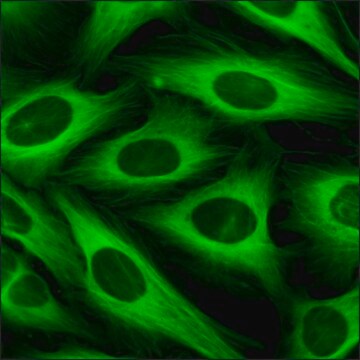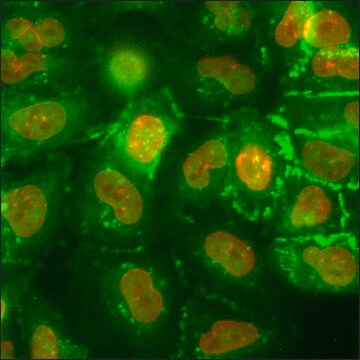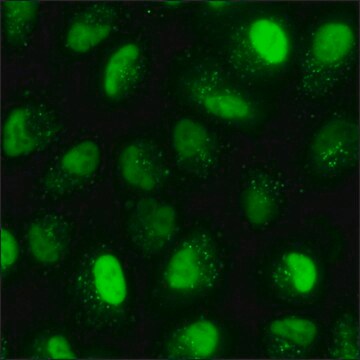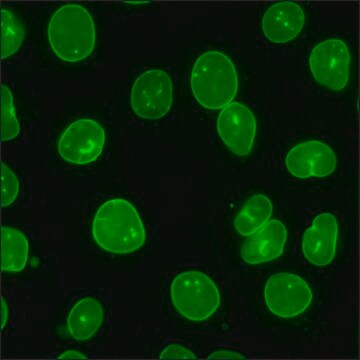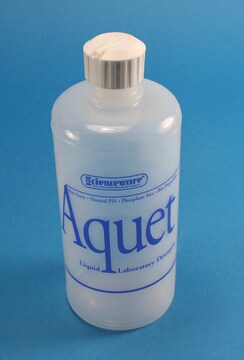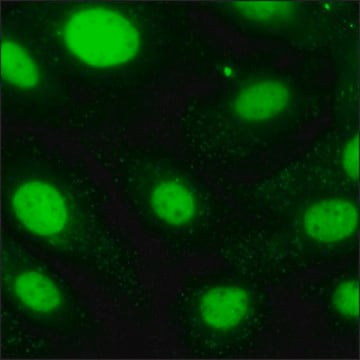CLL1218
U2OS LMNB1-TUBA1B-ACTB
human female bone (Disease source: Osteosarcoma)
Autenticatiper visualizzare i prezzi riservati alla tua organizzazione & contrattuali
About This Item
Codice UNSPSC:
41106514
NACRES:
NA.81
Prodotti consigliati
product name
U2OS LMNB1-TUBA1B-ACTB,
Origine biologica
human female bone (Source Disease: Osteosarcoma)
Livello qualitativo
Temperatura di conservazione
−196°C
Informazioni sul gene
human ... ACTB(60) , LMNB1(4001) , TUBA1B(10376)
Descrizione generale
U2OS LMNB1-TUBA1B-ACTB are bone osteosarcoma cells from a human 15 year old caucasion female having three distinct ZFN modifications creating a BFP-tagged LMNB1 transgene, a GFP-tagged TUBA1B transgene and a RFP-tagged ACTB transgene expressed from their endogenous gene locus.
This cell line was derived from ATCC Catalog No. HTB-96.
This cell line was derived from ATCC Catalog No. HTB-96.
Applicazioni
This product is a human U2OS cell line in which three genomic loci - LMNB1, TUBA1B, and ACTB - have been endogenously tagged with fluorescent protein genes for Blue Fluorescent Protein (BFP), Green Fluorescent Protein (GFP), and Red Fluorescent Protein (RFP), respectively, using CompoZr® zinc finger nuclease (ZFN) technology. Integration resulted in endogenous expression of: 1) the fluorescent fusion protein, BFP-laminB1, easily detected in the nuclear envelope; 2) the fluorescent fusion protein, GFP-α-tubulin, that polymerizes to form characteristic patterns of microtubules; 3) the fluorescent fusion protein, RFP-β-actin, that polymerizes to form characteristic patterns of actin fibers. Imaging of the cell line shows fluorescent labeling of the three proteins having normal cellular distribution patterns which makes the cell line ideal for high content screening to identify compounds that modulate cellular activity. This stable cell line was expanded from a single cell clone. The LMNB1, TUBA1B, and ACTB gene regulation and corresponding protein function are preserved in contrast to cell lines exhibiting overexpression from an exogenous promoter.
To learn more, please visit the Cellular Reporter Cell Line webpage
Azioni biochim/fisiol
Nuclear lamin B1, encoded by the LMNB1 gene, is an intermediate filament protein of the nuclear envelope. The protein exhibits transcriptional co-regulatory activity and plays a key role in DNA replication, cellular aging and stress responses. Thus, LMNB1 can be used as a potential biomarker for HCC.
Tubulin α 1b (TUBA1B) is a microtubule protein, which plays a vital role in dynamic process of polymerization and depolymerization during cell replication and division. TUBA1B is overexpressed in hepatocellular carcinoma (HCC) tumor tissues and proliferating HCC cells. This upregulated expression of the gene leads to poor prognosis and chemotherapy resistance in HCC.
Actin β (ACTB) is an abundant cytoskeletal housekeeping protein. The protein is expressed in the nucleus and controls gene expression, cell division and proliferation. ACTB is generally used as a reference gene in measuring expression levels in tumors.
Tubulin α 1b (TUBA1B) is a microtubule protein, which plays a vital role in dynamic process of polymerization and depolymerization during cell replication and division. TUBA1B is overexpressed in hepatocellular carcinoma (HCC) tumor tissues and proliferating HCC cells. This upregulated expression of the gene leads to poor prognosis and chemotherapy resistance in HCC.
Actin β (ACTB) is an abundant cytoskeletal housekeeping protein. The protein is expressed in the nucleus and controls gene expression, cell division and proliferation. ACTB is generally used as a reference gene in measuring expression levels in tumors.
Caratteristiche e vantaggi
Zinc Finger Nuclease (ZFN)-mediated targeted integration of three different fluorescent tags: LMNB1 is BFP-tagged on chromosome 5q23.2-q31.1, TUBA1B is GFP-tagged on chromosome 12q13.12 and ACTB is RFP-tagged on chromosome 7p22.1 to create a cell line exhibiting stable expression of all three transgenes.
The U2OS cells are adherent, with a doubling time of approx. 29 hours.
The U2OS cells are adherent, with a doubling time of approx. 29 hours.
Qualità
Tested for Mycoplasma, sterility, post-freeze viability, short terminal repeat (STR) analysis for cell line identification, cytochrome oxidase I (COI) analysis for cell line species confirmation.
Nota sulla preparazione
Media Renewal changes two to three times per week.
Rapidly thaw vial by gentle agitation in 37°C water bath (~2 minutes), keeping vial cap out of the water. Decontaminate with 70% ethanol, add 9 mL culture media and centrifuge 125 x g (5-7 minutes). Resuspend in complete culture media and incubate at 37°C in a 5% CO2 atmosphere.
Subculture Ratio: approx. 1:3-1:6
The base medium for this cell line is McCoy′s 5A Medium Modified, Cat. No. M9309. To make the complete growth medium, add the following components to the base medium: fetal bovine serum, Cat. No. F4135, to a final concentration (v/v) of 10%.
Cell freezing medium-DMSO 1X, Cat. No. C6164.
Rapidly thaw vial by gentle agitation in 37°C water bath (~2 minutes), keeping vial cap out of the water. Decontaminate with 70% ethanol, add 9 mL culture media and centrifuge 125 x g (5-7 minutes). Resuspend in complete culture media and incubate at 37°C in a 5% CO2 atmosphere.
Subculture Ratio: approx. 1:3-1:6
The base medium for this cell line is McCoy′s 5A Medium Modified, Cat. No. M9309. To make the complete growth medium, add the following components to the base medium: fetal bovine serum, Cat. No. F4135, to a final concentration (v/v) of 10%.
Cell freezing medium-DMSO 1X, Cat. No. C6164.
Note legali
CompoZr is a registered trademark of Merck KGaA, Darmstadt, Germany
Esclusione di responsabilità
RESEARCH USE ONLY. This product is regulated in France when intended to be used for scientific purposes, including for import and export activities (Article L 1211-1 paragraph 2 of the Public Health Code). The purchaser (i.e. enduser) is required to obtain an import authorization from the France Ministry of Research referred in the Article L1245-5-1 II. of Public Health Code. By ordering this product, you are confirming that you have obtained the proper import authorization.
Codice della classe di stoccaggio
10 - Combustible liquids
Classe di pericolosità dell'acqua (WGK)
WGK 3
Punto d’infiammabilità (°F)
Not applicable
Punto d’infiammabilità (°C)
Not applicable
Certificati d'analisi (COA)
Cerca il Certificati d'analisi (COA) digitando il numero di lotto/batch corrispondente. I numeri di lotto o di batch sono stampati sull'etichetta dei prodotti dopo la parola ‘Lotto’ o ‘Batch’.
Possiedi già questo prodotto?
I documenti relativi ai prodotti acquistati recentemente sono disponibili nell’Archivio dei documenti.
I clienti hanno visto anche
ACTB in cancer.
Guo C, et al.
Clinica Chimica Acta; International Journal of Clinical Chemistry, 417, 39-44 (2013)
Structural Organization of the Human Gene (LMNB1) Encoding Nuclear Lamin B1
Lin F, et al.
Genomics, 27(2), 230-236 (1995)
Circulating Lamin B1 (LMNB1) Biomarker Detects Early Stages of Liver Cancer in Patients
Sun S, et al.
Journal of Proteome Research, 9(1), 70-78 (2009)
Barney Boyce et al.
Scientific reports, 8(1), 14755-14755 (2018-10-05)
As an alternative to laser-based methods, we developed a novel in situ cell isolation method and instrument based on local water absorption of millimeter wave (MMW) radiation that occurs in cellular material and nearby culture medium while the cultureware materials
Increased α-tubulin1b expression indicates poor prognosis and resistance to chemotherapy in hepatocellular carcinoma.
Lu C, et al.
Digestive Diseases and Sciences, 58(9), 2713-2720 (2013)
Il team dei nostri ricercatori vanta grande esperienza in tutte le aree della ricerca quali Life Science, scienza dei materiali, sintesi chimica, cromatografia, discipline analitiche, ecc..
Contatta l'Assistenza Tecnica.

